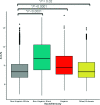Inequities in Health Outcomes in Children and Adults With Type 1 Diabetes: Data From the T1D Exchange Quality Improvement Collaborative
- PMID: 34421203
- PMCID: PMC8329009
- DOI: 10.2337/cd21-0028
Inequities in Health Outcomes in Children and Adults With Type 1 Diabetes: Data From the T1D Exchange Quality Improvement Collaborative
Abstract
Health care inequities among racial and ethnic groups remain prevalent. For people with type 1 diabetes who require increased medical access and care, disparities are seen in access to care and health outcomes. This article reports on a study by the T1D Exchange Quality Improvement Collaborative evaluating differences in A1C, diabetic ketoacidosis (DKA), severe hypoglycemia, and technology use among racial and ethnic groups. In a diverse cohort of nearly 20,000 children and adults with type 1 diabetes, A1C was found to differ significantly among racial and ethnic groups. Non-Hispanic Blacks had higher rates of DKA and severe hypoglycemia and the lowest rate of technology use. These results underscore the crucial need to study and overcome the barriers that lead to inequities in the care and outcomes of people with type 1 diabetes.
© 2021 by the American Diabetes Association.
Conflict of interest statement
O.E. is a compensated Health Equity Advisory Board member for Medtronic Diabetes and serves as the principal investigator for investigator-led projects sponsored by Abbott, Dexcom, Eli Lilly, Insulet, and Medtronic. No other potential conflicts of interest relevant to this article were reported.
Figures
References
-
- Berry JG, Bloom S, Foley S, Palfrey JS. Health inequity in children and youth with chronic health conditions. Pediatrics 2010;126(Suppl. 3):S111–S119 - PubMed
-
- Chalew S, Gomez R, Vargas A, et al. . Hemoglobin A1c, frequency of glucose testing and social disadvantage: metrics of racial health disparity in youth with type 1 diabetes. J Diabetes Complications 2018;32:1085–1090 - PubMed


